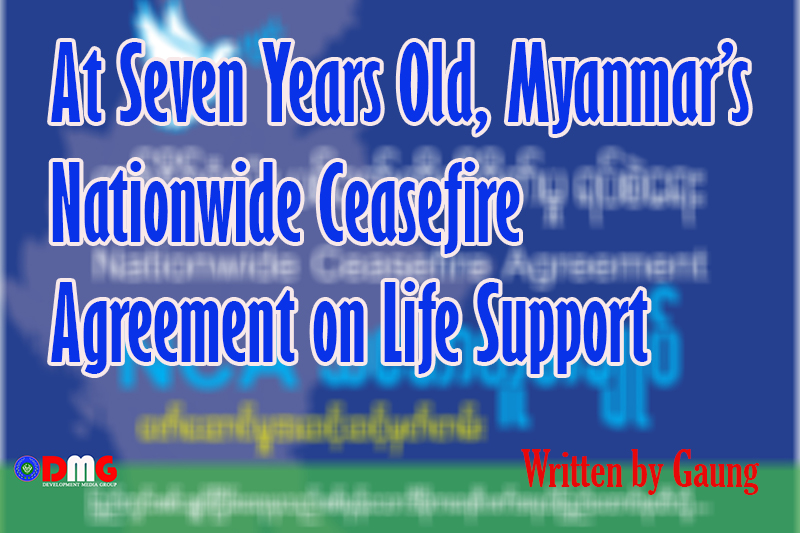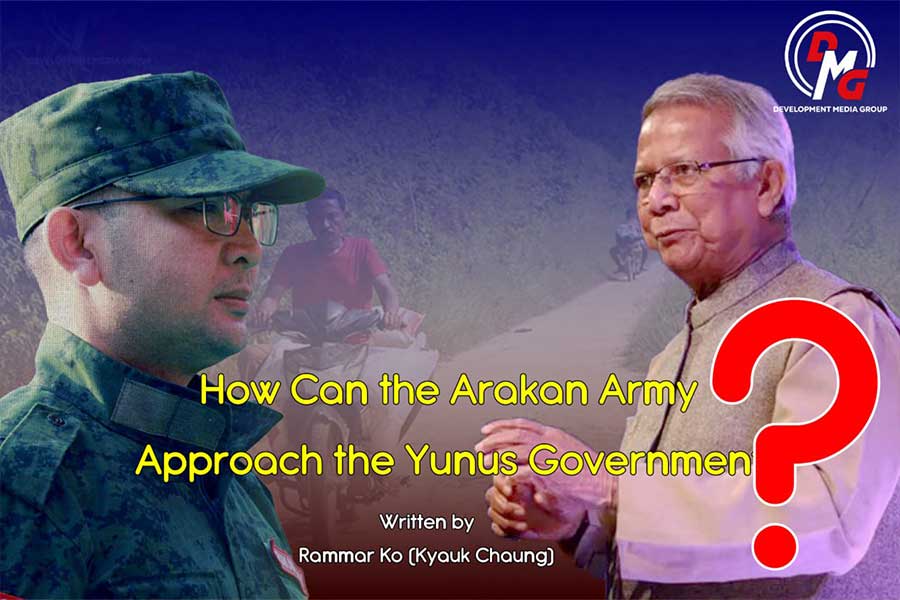- 2025 Review of Arakan State
- Manaung residents hit hard by junta blockade
- How the Arakan Army Can Engage the Yunus Government Amid Myanmar's Election Push, Border Pressures, and a Deepening Arakan Crisis
- Thandwe civilians sleep in bomb shelters amid junta air attacks
- Nearly 900 civilians killed or injured in Arakan State over one year: DMG tally
At Seven Years Old, Myanmar’s Nationwide Ceasefire Agreement on Life Support
The Myanmar military, government and NCA signatories held the first session of the Union Peace Conference in August 2016 under the peace framework outlined by the NCA. In addition to the leaders of NCA signatories, representatives from some non-signatory EAOs addressed the conference. No official agreement was reached at the end of the conference, however.
18 Oct 2022

Written by Gaung
The Nationwide Ceasefire Agreement (NCA), which is considered by some to be the second-most significant milestone in Myanmar’s peace process after the Panglong Agreement of 1947, turned seven years old on October 15, 2022.
The leaders of several ethnic armed organisations (EAOs), the government and the military, based on the idea of resolving conflicts through political dialogue instead of fighting, officially signed the Union-level pact with great fanfare on October 15, 2015.
The NCA is aimed at establishing a Union based on democracy and federalism that guarantees self-determination in accordance with the so-called “Panglong Spirit,” while upholding the principles of non-disintegration of the Union, non-disintegration of national solidarity and perpetuation of sovereignty.
Even in the post-coup period, the Myanmar military believes the NCA is the door to peace; it is said to be the only pact in the country’s long history of internal armed conflict that guarantees political dialogue. Consenting EAOs signed the NCA because they believed that they would be able to effectively mitigate the most problematic aspects of the army-drafted 2008 Constitution by amending and supplementing it.
President U Thein Sein’s government invited EAOs to peace talks starting in 2011, and engaged in nearly four years of talks with the ultimate goal of an NCA eventually coming into focus.
Eight EAOs — the Restoration Council of Shan State (RCSS), Karen National Union (KNU), Democratic Karen Benevolent Army (DKBA), Karen National Union/Karen National Liberation Army-Peace Council (KNU/KNLA-PC), Pa-O National Liberation Organization, All Burma Students Democratic Front (ABSDF), Arakan Liberation Army, and Chin National Front (CNF) — initially signed the NCA.
Two more EAOs — the New Mon State Party (NMSP) and the Lahu Democratic Union (LDU) — also signed the NCA under the National League for Democracy (NLD) government on February 18, 2018, bringing the total number of NCA signatories to 10.
The NCA is now more than seven years old. During the intervening years, four sessions of political dialogue known collectively as the Union Peace Conference/21st Century Panglong were held.
A ‘Panglong’ for the 21st Century
The Myanmar military, government and NCA signatories held the first session of the Union Peace Conference in August 2016 under the peace framework outlined by the NCA. In addition to the leaders of NCA signatories, representatives from some non-signatory EAOs addressed the conference. No official agreement was reached at the end of the conference, however.
The second session was held in May 2017, when 37 points were agreed to. The third session was held in July 2018, and 14 agreements were reached at that session. Union Accord Parts I and II, which include a total of 51 provisions, were subsequently approved by the Union Parliament.
The fourth iteration of the Union Peace Conference was held on August 21, 2020, and Union Accord Part III was signed. It includes 20 points of agreement and work plans and implementations for the post-2020 election period.
So, there are a total of 71 agreements in the three accords reached at the Union Peace Conference, which uses the NCA as its roadmap. However, the Union Accord does not have any provisions on power-sharing, troop deployments or state charters, which are integral parts of the demands of ethnic people.
Important Points
Chapter 3 of the NCA focuses on how to avoid armed conflicts. According to Section 7 of the NCA, it is agreed to avoid confrontations in areas where there is direct contact between troops, by acting immediately using radio, ground communications or other methods of communication.
It is also agreed to cease the following actions in ceasefire areas: troop movements for territorial control, reconnaissance, recruitment, armed attacks, laying of landmines, acts of violence, destruction of property, and launching of military offensives. According to Section 8, the Myanmar military and EAOs also agree to allow free movement of unarmed troops in all areas except in security-restricted areas, and to seek prior approval for the movement of armed troops in areas controlled by others.
The two sides also agree to act with transparency, responsibility, and accountability, and effectively implement the provisions in the NCA without taking advantage of developments.
In the weeks, months and years following the signing of the NCA, military tensions rose gradually in some parts of the country, as certain provisions of the agreement were said to have been violated by various parties to the accord.
The Myanmar military expanded its territorial control and military presence in some places, and arrested and charged some members of EAOs who had signed the NCA under Section 17/2 of the Unlawful Associations Act. Civil activists and youth leaders who protested against the war in Arakan State were also prosecuted under various statutes.
The Myanmar military built a road in Papun District, an area controlled by the NCA-signatory Karen National Union (KNU), under the pretext of local development, and clashes have since become frequent.
On the other hand, multiple NCA-signatory EAOs have been involved in recruitment, military reinforcement and collection of taxes from locals in areas under their control.
In matters related to the NCA, it is stated that “the signatories to the NCA must be serious about not fighting, and the terms contained in the treaty must be enforced,” but both sides have violated their commitments for various reasons and to various degrees since the agreement was signed in 2015.
Confidence in NCA Wanes
The terms of the NCA have become further disregarded in the wake of the military coup. There have been major battles pitting the Myanmar military against NCA-signatory EAOs such as the KNU and Chin National Front (CNF), and the confidence of ethnic armed groups and the people in the NCA is low. Several EAOs have also supported anti-regime groups that have sprung up in the aftermath of the coup.
The government, parliament, military, political parties and EAOs must all be involved in the political dialogue on the NCA path, but since the military coup, there is no more parliament; there is no forum to ratify political dialogue agreements. As a result, the peacemaking process through the NCA is in question, and NCA implementation processes have come to a standstill.
The fact that multiple NCA-signatory EAOs oppose the military coup shows the extent of the distrust in the NCA. Due to the junta’s use of force to suppress people opposed to the military coup, a significant segment of the Burmese people — who had previously only heard about wars in the country’s ethnic regions from a distance — began to take up arms against the military themselves.
Fierce clashes have been ongoing across Myanmar since the military coup. This has involved both EAOs and People’s Defence Forces (PDFs) fighting against the military regime.
It must be said that due to the differences in the political paths of each of the ethnic armed groups, any future success of Myanmar’s peace process will be almost impossible under the NCA framework as it currently exists.
In order for the revolutionary forces to build a true federal union, an increasingly mainstream view is that a peace path other than the NCA is needed, whether it be via the fall of the military dictatorship or a new constitution that can be inclusively discussed and drafted.
However, the military junta has clung tightly to the NCA as the foundation of the peace process. Junta-controlled state-run newspapers have stated that the military regime’s political orientation and policy includes “emphasising the NCA to achieve lasting peace in the country.” Along those lines, the military council is currently discussing peace with the 10 NCA signatory EAOs, as well as some NCA non-signatories.
Meanwhile, there are still many ethnic armed groups that are determined to have no discussions at all, saying the military junta has unjustly seized power and noting that it is not a government elected by the people.
Overall, the military and EAOs have not been able to build trust among themselves since the signing of the NCA, and due to disagreements, they have reverted to conflict and skirmishes in some cases. Since 1948, Myanmar has been said to have gained independence, but the people have not yet experienced the essence of independence and peace, and are still stuck in a cycle of military conflict and poverty.
In addition to further delaying development and the creation of job opportunities in the ethnic areas, the country is losing human resources every day, and the people are facing terrible crises. These things can be attributed to the failings of the political road map laid out in the NCA, as well as NCA non-compliance and, importantly, the devastating repercussions of the 2021 military coup.
The Peace Process Steering Team (PPST) of the NCA-EAOs said in a statement on October 14 that the people are in crisis because the original NCA provisions cannot be fully implemented. In order to escape from these crises, the PPST said in the statement that it has been trying to implement three basic principles: solving the political problems of the NCA through political means, holding meaningful political discussions involving all stakeholders, and protecting civilians.
The chairman of the State Administrative Council (SAC), Senior-General Min Aung Hlaing, said in a speech marking the seventh anniversary of the NCA’s signing that he would stand firmly on the NCA and the 2008 Constitution.
This appears to reflect an unwillingness to consider legitimate concerns about the inadequacies of the NCA in 2022, and as the senior-general has brought EAO representatives to Naypyidaw for discussions in the post-coup period, the smell of gunpowder and the smoke of burning villages has been hard to ignore.




















